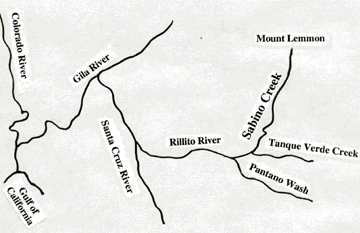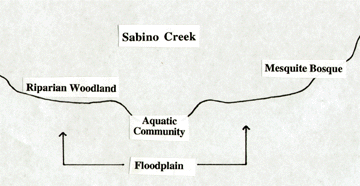
|
|
Sabino Creek
|
For ten million years, Sabino Creek has been carrying water through Sabino Canyon. The creek flows from the top of Mount Lemmon at 9,000 feet to just 3,000 feet into Lower Sabino Canyon. The creek rises with the heavy rains of summer and with the winter rains and snow melt run-off from Mount Lemmon. The creek runs slower and becomes smaller as drought conditions return to the desert between these two rainy seasons. Sabino Canyon itself gets about 13 inches of rainfall in an average year. Depending on the rainfall, the creek flows between 9 and 12 months each year. There are three plant communities that make up the habitats in or near the creek at the bottom of the canyon:
The creek has an *ecosystem* of its own. The *algae*, tiny one-celled plants that we call pond scum, and *muck*, the decaying plants and animals on the creek bottom, are the breeding and feeding grounds for many insects including dragonflies, mayflies, and mosquitoes. Snails, tadpoles, and crayfish live in the creek as do Sonoran mud turtles and Gila chubs, the only native fish that live in the creek. Flooding is an important part of the annual cycle of Sabino Creek. To learn why flooding is important, read the Sabino Creek - Flood page. |
|
© 2001-2018 Judi Moreillon |








